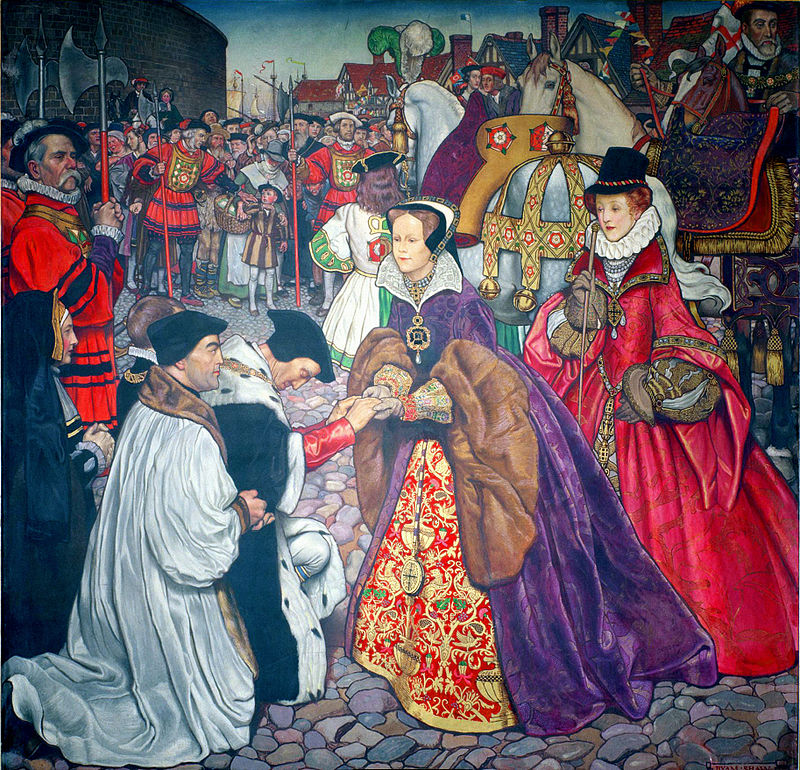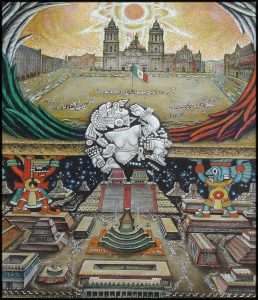Winner of the Fall 2016 StMU History Media Awards for
Article with the Best Title
No one can say who history will choose to remember, or for what they will be remembered. Sometimes a lifetime of achievement can be forgotten because of a single misdeed. Few historic figures relate to this statement more than the English Queen Mary Tudor. Remembered today as a drink, or as a ghost story told by young children, Queen Mary was the first self-reigning queen of England during a time of radical religious change within her realm. The atrocities she committed during her reign would forever live on, and earn her the nickname Bloody Mary.
Mary Tudor was born in the year 1516 to King Henry VIII and Catherine of Aragon. Although he wanted a son, King Henry was very fond and proud of Mary, whom he showed off to many people in the castle and in the London markets. As he was showing her off to a French envoy, King Henry was heard shouting “By immortal God, Master Ambassador, this girl never cries!”1 Beginning at the tender age of six, Mary was offered up for marriage multiple times, including to her cousin Charles V, the Holy Roman Emperor, and to the son of King Francis I of France, and even to King Francis himself. She was crowned by her father as the first princess of Wales.
Because Catherine had not given him a son, King Henry sought to annul their marriage. However, at the insistence of Catherine, Charles V and papacy refused to grant Henry the annulment. Henry did not take kindly to their refusal and sought to distance himself from their ecclesiastical rule to establish his own.With his new adviser, Thomas Cromwell, a known Protestant, by his side, King Henry announced the Act of Succession, formally separating the England from the authority of Rome. He then enacted the Act of Supremacy, which placed him as the head of the new Church of England.2
Much of northern England discontented with the current state of affairs. Growing ever more restless with rising taxes, hardships, and now the separation from the Roman Catholic Church, many villages began to revolt. Cromwell sought to quell the rebellion by enacting the Pilgrimage of Grace. Many monasteries and places of worship were burned to the ground while the government issued the Ten Articles of Religion, religious rules that had to be practiced, many of which heavily favored Protestant traditions. These actions only led to further uprisings that eventually posed a threat to King Henry’s rule.3
Once again under the guidance of Thomas Cromwell, King Henry executed over two-hundred of the insurgents, effectively ending the uprising. A young Mary watched as her father sentenced his enemies to death, establishing his power and right to reign through force. This display of power would shape Mary and her eventual reign as monarch.4
Mary was very close to her mother growing up, and believed very deeply in the Catholic traditions and values instilled in her at a young age. After Catherine’s annulment, Mary quickly sided with her mother and developed a deep hatred of Henry’s new wife, Anne Boleyn. Angry that Mary chose to side with Catherine instead of him, Henry separated Mary from her mother, stripped her of her title,which she would never regain in her lifetime. After the birth of her new half sister Elizabeth, Mary became illegitimate in the eyes of the royal court and lost all right to the throne. She was forced to live in Elizabeth’s house, where she was hated and reviled by her step mother Anne Boleyn until her execution years later. Scholars believe Mary suffered from congenital syphilis, which she inherited from her father. This, coupled with the psychological stress she endured, caused her to spend the next several years in and out of severe illness.5

On 12 October 1537, Edward VI was born to King Henry and his third wife, Jane Seymour. Now Henry finally had a son who would succeed him upon his death, which happened in 1547. Under Edward’s rule, Protestantism was given Edward’s full sponsorship, and an English Reformation ensued, which brought a thorough-going persecution of all things Catholic. Despite this, Mary continued to practice her faith, holding mass in her private chapel, which was in open defiance of the many religious laws put in place at Edward’s behest. Edward’s rule, however, was short lived; he reigned only six years before dying of illness. Before he died, Edward altered the line of succession to ensure that Lady Jane Gray, a Protestant and grand-daughter of King Henry’s sister, would take the throne instead of his half-sister Mary. Lady Jane became queen, and Mary was forced to flee for her life from the castle. She was faced with a choice: flee the country, or try to oppose her rule.6
To the surprise of many, Mary garnered large support and loyalty from many subjects, including East Anglian nobility. In a matter of days she had amassed an army strong enough to oppose the English council and end the rule of the nine-day queen. At 37 years old, Mary Tudor ascended to the throne. In 1554 Queen Mary issued an order, which declared that queens held equal power to kings, effectively becoming the first regnant queen of England.7 As a monarch Mary worked ceaselessly in the name of her kingdom. It was said that she woke up at dusk to pray, then worked in government well passed midnight. Despite the struggles she had endured throughout life, and the cruelty she later become known for, Mary was described by many as kind and caring woman. She was known for interest in fine jewelry while still insisting she remained a simple woman, with an inclination towards gambling.8
Mary immediately worked towards reestablishing the papacy’s control over England. She began a reverse Reformation, undoing many of the religious laws in place and replacing them with new laws meant to reestablish Catholicism in England. Many disagreed with her efforts, and did not believe she had a right rule. Uprisings began as people defied many of the religious laws she put into place, practicing their faith in secret as Catholics had done only a few years ago. As her father had done before her, Queen Mary established her power and authority by executing all those who defied the new laws. Protestant prisoners were dragged from their cells, tied to stakes, and burned alive for all to see. Often times these prisoners were covered in hot tar to make the flames burn longer. Many of the people executed were young. Mothers were burned alongside their children. An estimated 294 were believed to have died under her rule9.

For Queen Mary, these executions were not just punishing those who broke the religious laws of the land, but a way of purifying England so as to restore it to its former state of communion with Rome. As she had witnessed from her father before her, public executions were also an efficient way to establish power and dominance over the people, great and small. This may have been a necessary power play, since many doubted whether she actually had the strength to rule, because she was a woman. These executions did produce the desire outcome; however, the people sacrificed to the flames soon became martyrs, and Protestant sentiment grew even stronger among its followers. Those who escaped her purge began referring to the queen as “bloody Mary,” because of all of the Protestant blood she had shed.10
Despite the loyalty she had garnered among her followers, many people still believed a queen would be too weak to rule on her own. Many members of her council had also served under Lady Jane as well, providing more obstacles for her to overcome. Mary knew she needed to produce an heir to ensure that Elizabeth would never ascend to the throne. She married King Phillip II of Spain, son of Emperor Charles V, a decision that many considered to be the worst in her reign. Sir Thomas Wyatt, a Protestant leader, staged a rebellion against the matter, led by many other prominent Protestants. Many years into their tumultuous relationship,Phillip convinced Mary to aid Spain in his war against France. which she did, and it resulted in massive losses for the English navy.11

Like her brother before her, Mary’s reign was short lived, lasting only five years. She died in the year 1558, after finally succumbing to illness.12 Elizabeth was then crowned reigning monarch, devoting her time as queen to rebuilding the Church of England. As her father had done before her, Elizabeth sought to establish a middle ground between the two warring religions. She instilled traditions from both Catholicism and Protestantism to establish peace among the people.
Though a trail blazer in every sense of the word, Queen Mary is instead remembered as the “Tyrant Tudor” reviled by many for the ferocious acts she committed in the name of her faith.13
- Neil Jones, “The Rise and Fall of Bloody Mary,” Britain 84, no. 2 (April 2016): 66. ↵
- Salem Press Biographical Encyclopedia, January 2016, s.v. “Henry VIII,” by William T. Walker. ↵
- Salem Press Biographical Encyclopedia, January 2016, s.v. “Pilgrimage of Grace,” by Sharon L. Arnoult. ↵
- Niki Incorvia, “A Threshold of Genocide: Microgenocide in Mary Tudor’s Revenge on Protestant England and Catherine de Medici’s Massacre of the Huguenots,” International Journal of Religion & Spirituality in Society 5, no. 3, (September 2015): 54. ↵
- Columbia Electronic Encyclopedia, April 2016, s.v. “1516–58 Mary I, Queen of England.” ↵
- Salem Press Biographical Encyclopedia, 2016, s.v. “Mary I.,” by Ann Weikel. ↵
- Salem Press Biographical Encyclopedia, 2016, s.v. “Mary I,” by Ann Weikel. ↵
- Neil Jones, “The Rise and Fall of Bloody Mary,” Britain 84, no. 2 (April 2016): 66. ↵
- Niki Incorvia, “A Threshold of Genocide: Microgenocide in Mary Tudor’s Revenge on Protestant England and Catherine de Medici’s Massacre of the Huguenots,” International Journal of Religion & Spirituality in Society 5, no. 3 (September 2015): 54–55. ↵
- Niki Incorvia, “A Threshold of Genocide: Microgenocide in Mary Tudor’s Revenge on Protestant England and Catherine de Medici’s Massacre of the Huguenots,” International Journal of Religion & Spirituality in Society 5, no. 3 (September 2015): 54–55. ↵
- Columbia Electronic Encyclopedia, April 2016, s.v. “1516–58 Mary I, Queen of England.” ↵
- Columbia Electronic Encyclopedia, April 2016, s.v. “1516–58 Mary I, Queen of England.” ↵
- Neil Jones, “The Rise and Fall of Bloody Mary,” Britain 84, no. 2 (April 3, 2016): 66. ↵



194 comments
Danielle Slaughter
This article truly fascinated me. What I found interesting was that, as a child, she had witnessed all her father’s cruelty against the Catholic dissenters and still retained that faith, yet at the same time employing her father’s same methods against the Protestants. Personally, I gathered that she was not an *evil* woman, just thrown into the midst of a tumultuous time period with only the psychological scars of her youth and a hatred beyond comprehension. Of course, one cannot excuse her tyranny or her awful methods of execution, but she is still a highly important figure in the history of England.
Tyanne Pearcy
This was a well written article about a topic I was not well informed on but kept my attention all the way through. It was shocking to know that Queen Mary was not a great queen which is upsetting since she was the first female to be a ruler over England. The fact that she would have people killed if her people didn’t agree with her beliefs is a perfect example of tyranny. It is crazy how much her dad made her into the way she was.
Esperanza Rojas
This article had me interested from the beginning to the end, it was very well written using imagery and good diction that it hardly seemed that I was reading this for an assignment. The topic was interesting as well, and I liked how the author went into the effect her father’s actions had on Mary, especially because she admired her father, even when he annulled from the Church. Mary is seem as a horrible queen because of her preference of religion but she was a strong one that ruled for very long.
Jabnel Ibarra
The Tudors of England share a long, complicated and bloody history that define much of the laws and policies of modern England and much of the New World as a result. King Henry’s efforts to distance the nation from the Catholic Church (which is a complete story in its own right) would directly and significantly impact countless lives, including and almost especially that of his daughter Mary. Though I should have made this connection, it had never occurred to me before reading this article that Queen Mary was the origin behind “Bloody Mary”.
Sofia Andrade
Before reading this article I was not aware of Queen Mary. It is sad to hear her tragic childhood and life. Although she had many obstacles she still managed to reign. Throughout her hardships it is safe to say that Catholicism kept her going. This is why she enforced these brutal laws against those who didn’t practice Catholicism. Her gender also played a crucial role in her being able to reign which is why Mary declared that Kings would hold equal power as Queens.
Richard Morales
This article is a great read and was very well written. The Tudor family is extremely evil and it is hard to believe that their reign existed. Queen Mary and her father did such evil things to their subjects just based off of religious views. It is sick how people can lose their humanity when given ultimate power. She was the first woman to rule over England, in my opinion she was a terrible Queen.
Brianna Ford
I did not know about Queen Mary, just the story called “bloody Mary.” I never knew there was actually a real person behind the story. I wonder if that story is true, I’ve never tried it though. I personally believe that she was not a good queen, although being the first woman to rule over England. She would have people killed all because they did not agree with her religious views. This was a very good interesting article. Good job!
Raymond Munoz
Throughout this whole article I couldn’t help but think of Marvel’s “Thor: Ragnarok,” because some aspects of the movie seem to parallel that of the story of Bloody Mary. For example, in the movie there is a king who’s first child is a girl and even though he wanted a son he grew to love her and desired her to rule at his side. Though, having her shadow him turned out to be a mistake because the daughter adopts his ruthlessness and raises to a whole other level, just like Mary observed her father and went on to practice his horrors. Making connections like that of the story and the movie help me learn and comprehend what is going on.
Emily Jensen
The Tudor family will always make for a great read, but Queen Mary takes the cake as most intriguing. I found it interesting that she condemned her father, while he was alive, for beheading his wives and burning so many people at the stake, and yet she did the exact same thing during her reign. This article was very informative, though I wish they had gone into detail about her rocky relationship with her sister, Elizabeth.
Eric Ortega Rodriguez
Wow. This article is very fascinating and well written. As a child, I would hear stories about Bloody Mary numerous times but never knew or thought about looking into this topic, so good topic choice! I found it interesting and horrid that as a child Mary Tudor saw executions with her father, which is probably what made her such a rough and enduring individual, especially with all the unusual circumstances she had growing up. I also find it so horrifying how she would execute people for having a different belief than her, in terms of religion. Which ultimately led to her nickname, giving her the nickname of Bloody Mary.